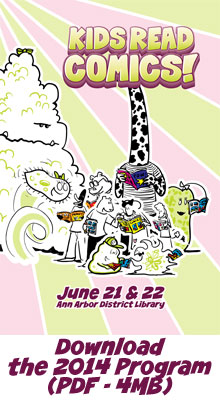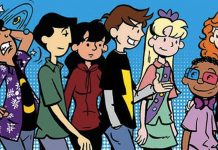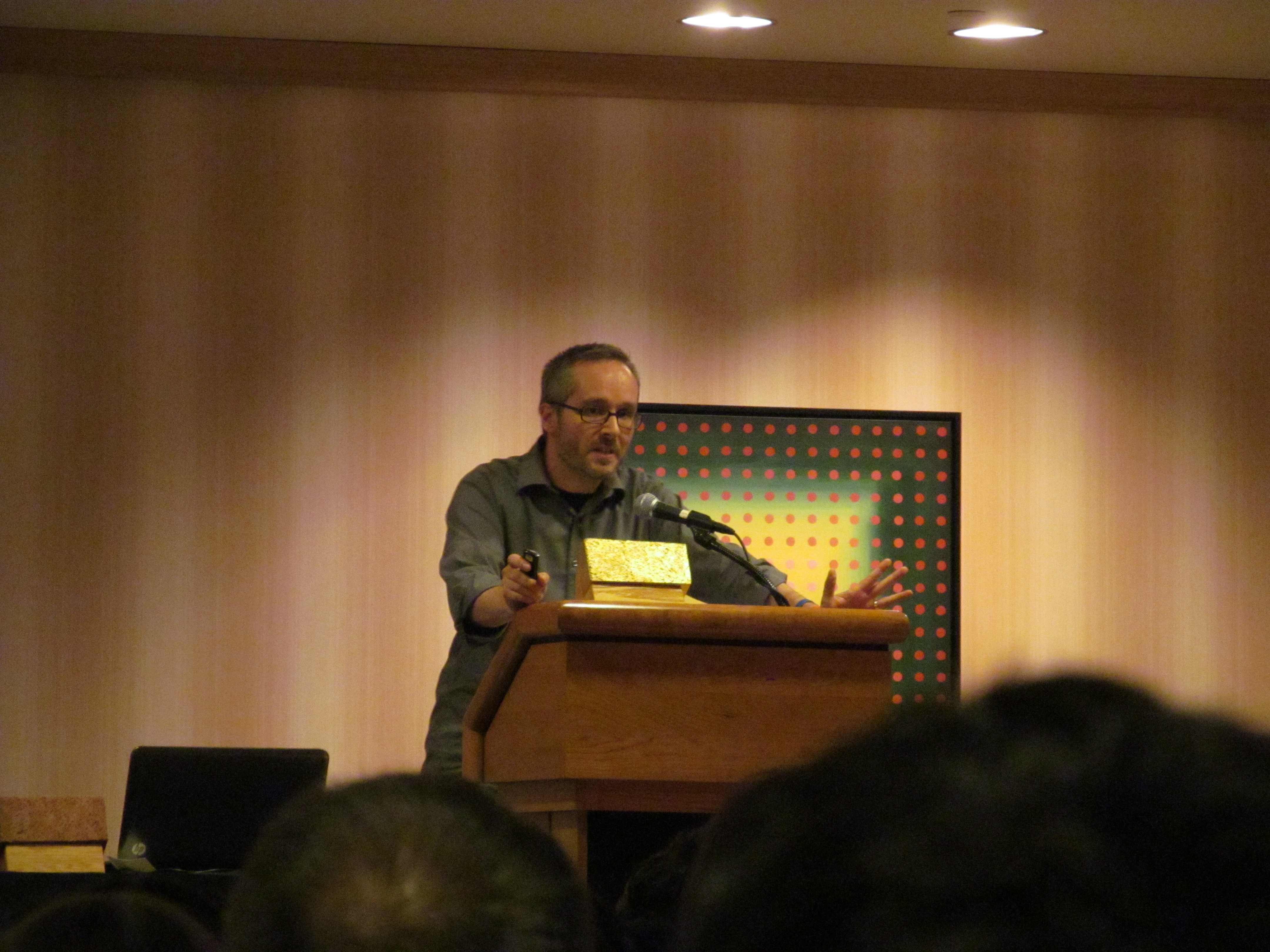By Dave Carter
This coming weekend (June 21-22, 2014) will mark the sixth annual Kids Read Comics Festival. KRC brings together kids (and their families) and cartoonists for two days of comic-centered fun, combining a tradition comics convention with hand-on workshops and other activities.
Last week via email I interviewed one of the KRC founders, teaching artist/cartoonist Jerzy Drozd, about the history of KRC and how the festival has evolved over the years. I had intended to work with Jerzy’s responses to craft a narrative, but his responses were so well-constructed that they really form a narrative on their own. So I present them here with minimal editing.

——
What is the ‘secret origin’ of Kids Read Comics? When, where and why did it start? Why did you and your colleagues feel there was a need for a convention/festival/show focused on kids?
The four organizers (Dan Mishkin, Dan Merritt, Edith Donnel, and myself), all followed our own vectors into making what became the Kids Read Comics celebration, and all I can share is the story of how I became involved.
In 2006 I met Dan Mishkin at Heroes Con. During our conversation he handed me a flier with information about Alex Simmons Kids Comic Con, one of the first (if not THE first) comics convention with the explicit intent to serve kids and families. On the flier Dan expressed an interest in starting something similar for the kids of Michigan. At that time I agreed it was a great idea, though I had no idea how I could help. I was making comics for kids, but I had nothing to offer such an event outside of being an exhibitor.
A year later I found myself working as a teaching artist for organizations like ArtServe Michigan’s Literacy Arts Comic Book Project, The John F. Kennedy Center for the Performing Arts, and local schools and libraries. When I saw the difference in how kids engage with comics when they participate in the medium, I realized how I might be able to help Dan realize his “comics convention for kids.” Rather than simply exhibit at such a show, I could help advocate for my medium by creating workshops and experiences that get kids really excited about making and reading comics.
It was during these visits to schools and libraries that I met Edith Donnel, Teen Librarian at the Chelsea District Library. After leading a well-attended 6-week comics workshop at her library, Edith expressed an interest in creating some more substantial comics events for kids. I told her about Dan Mishkin’s idea, and she suggested holding the “comics convention for kids” at her library.
Though the Chelsea District Library was well-versed in leading big events (CDL’s Summer Reading kickoff gets the whole town to turn out), we still felt we needed some help in crafting a unique comics event. Dan Mishkin and I both thought of the terrific duo Dan and Katie Merrit of Green Brain Comics, whose Free Comic Book Day festivities are practically a one-day comics convention/advocacy event. We were very glad when they agreed to join us as founding organizers.
From the beginning we realized that a “convention for kids” had to feel different than most comics cons. Of course we would place our focus on showcasing creators whose works are aimed at younger audiences. At traditional comic cons, however, the interactions between creator and fan are mostly in the way of autographs, photo opportunities, panel q&a, and maybe sketch purchases. These can be very rich interactions, but having seen how kids engage with comics when making comics we believed that KRC could do something more.
You don’t have to compel a kid to draw. They’re eager to interact and participate with the things they love. What’s more, by participating in the medium, they better appreciate and enjoy the experience of the medium. In other words, by encouraging writing and drawing, we would help kids become better and more active comics readers. The question we asked ourselves was: How might a convention interaction change if, instead of simply meeting their favorite author, we provided them with the opportunity to draw along side of their favorite author?
(For adult readers, just imagine going to a comic con and instead of simply getting Jack Kirby to autograph your issue of Fantastic Four, you get to sit down and take a free comics class led by him.)
These powerful interactions have led to kids exhibiting their work at Kids Read Comics. At KRC 2010, guest Ryan Estrada met a 7-year-old girl who showed him her series of comic strips along with character designs, relationship charts, and copious notes on where her story was going. She asked Ryan “what does it take to be a professional?” Ryan is a pretty sharp guy, so he had the presence of mind to respond “You already are. What separates you and me is that I’m behind the table. Get in touch with the KRC folks and se about tabling next year.” That young girl did get in touch with us and was a guest at KRC 2011. She’s also a guest at this year’s show. (You can listen to a recording of Ryan telling the story at http://audioboo.fm/boos/140782-best-story-ever )
Once we reframed the notion of a comics convention for kids, we realized that we had the opportunity to do something unique. Kids Read Comics is about promoting great comics for kids. But it’s equally about getting kids to love making comics, thereby making them more active readers of comics. As Dan Mishkin likes to say, “we’re in the business of changing lives.”
When was the first KRC? How has it evolved?
Over the years we’ve experimented with different venues and formats for KRC. Our first show in 2009 was held at the Chelsea District Library, which featured an indoor Artist Alley with many of our hands-on workshops and programs happening both indoors and outdoors. In 2010 we moved to the Dearborn Public Library, which had an impressive amount of space for workshops and demonstrations. We took an “outdoor festival” approach with KRC 2011, returning to the Chelsea District Library. The events at our 2011 show happened all over Downtown Chelsea; we held our interactive Quick Draw events in front of many of the local businesses who also participated in our town-wide scavenger hunt (in which kids were invited to find KRC trading cards containing clues to find the next event location). The Artist Alley was also split between two different locations in Chelsea, which presented an interesting challenge in setting up events to guide the attendees to the artists’ locations.
In 2012, however, we came to roost at the Ann Arbor District Library. We continue our experiments with different venues and programs, but instead of bouncing between towns, we operate within Ann Arbor. This year KRC programs will happen at the Ann Arbor District Library, 826 Michigan, and the Ann Arbor Art Center.
How many people attend KRC?
It’s difficult to give solid numbers because attendance is free with no registration required. Our first year we estimated around 700 attendees, and we had between 1,000-1,500 at our 2013 event.
The most encouraging thing for me is how the show seems to attract a lot families who aren’t necessarily “die-hard” comic book fans. There’s a large investment required in becoming the kind of fan who travels and pays registration fees to meet an actor from a sci-fi TV show or see a panel of creators talk about what’s next for the DC Universe. Because KRC is a free show with a large emphasis on participating in making comics, we’re providing a low-risk way for the general public to explore their curiosity about the medium. What I mean by “low risk” is that you don’t have to hold a doctorate in a fandom’s headcanon in order to participate. Programs like Mark Mariano’s Doodle! Scribble! Draw! get cartoonists and attendees working together to create a visual narrative that only requires imagination and the courage to share one’s work. We’re grateful that KRC attracts engaging, outgoing cartoonists who sincerely want to get people to fall in love with comics. They’re the most important element in attracting the kind of audience you’ll find at KRC.
KRC is free to attend and there is no charge for artists and writers to table. How can you all afford to put on the show?
Since the beginning KRC has relied on the support of forward-thinking libraries like the Chelsea District Library, the Dearborn Public Library, and the Ann Arbor District Library. We also fund our events through grants like the Michigan Council for Arts and Cultural Affairs and the National Endowment for the Arts, donations from local businesses, and fundraising at conventions and Free Comic Book Day at Green Brain Comics. Another big component in making KRC happen is partnerships with similarly-spirited organizations like the University of Michigan, the Ann Arbor Book Festival, 826 Michigan, and the Ann Arbor Art Center. We four founders gather the cartoonists and put on the show, but it is our partners who provide the venues and resources to make the show possible.
One of the many reasons KRC landed and roosted at the Ann Arbor District Library is the incredible support and resources they provide us. I’m going to interpret the word “afford” to refer to time as well as money, and time is a big one for us, as none of the KRC founders make a dime off of this event. We donate our time to put on the show, and we all have day jobs, so efficiency becomes very, very important. I cannot overstate just how terrific the staff is at AADL. They’re the most competent, committed, and enthusiastic group of people you’re likely to meet, and without their help we just simply couldn’t do any of the really exciting things you’ll find at KRC.
If a creator is interested in participating in KRC, what steps should they take?
The primary qualifications we’re looking for in KRC guests are having a kid-friendly comic, an engaging presence, and a desire to share one’s joy in making comics through a demonstration or workshop. An important distinction between KRC and many other comics shows is that our principal focus is on advocacy. This isn’t a show for the timid or misanthropic!
Disclaimers out of the way, we hold open applications for tables around February of every year. You can follow the KRC Twitter account (http://twitter.com/krcomics) or the KRC Facebook Page (https://www.facebook.com/kidsreadcomics) for updates. As with most shows, space is limited, but we do our best to fit in nearly everyone who applies.
What have you learned from organizing KRC about comics as a medium?
Anyone who has been around the comics industry for the last 20 years will recall plenty of dire predictions about the “inevitable fall” of comics. In working with committed partners outside of the comics industry, like libraries, universities, literacy advocacy organizations, as well as outgoing, enthusiastic cartoonists, I’ve gained more confidence that comics will be enjoyed by readers for a long time.
————
Details on this year’s Kids Read Comics Festival can be found on the KRC Website at http://mlatcomics.com/krc/ . You may also wish to view this promotional video on YouTube: http://www.youtube.com/watch?v=jtUjjmWQ0NI
Jerzy Drozd is a teaching cartoonist and illustrator. His latest work, with Dan Mishkin and Ernie Colón, is The Warren Commission Report: A Graphic Investigation into the Kennedy Assassination; it will be released in September by Abrams ComicArts.








Thanks for the great article about KRC!
A couple minor spelling corrections: Edith’s last name is actually Donnell with two “L”s (misspelled in first and third paragraph of question #1), and Dan and Katie’s last name is actually Merritt with two “T”s (spelled correctly in the first paragraph of #1, but misspelled in paragraph 5). Ryan Estrada’s quote in the second to last paragraph of #1 also misspells “see” as “se”.
Thanks again for the great article about this awesome event!
Comments are closed.